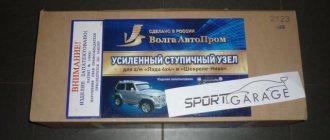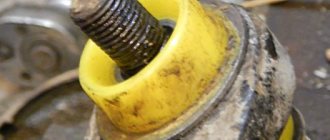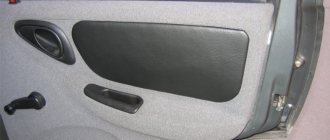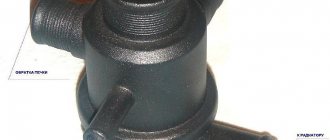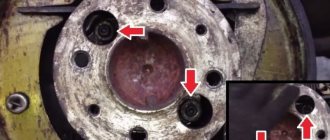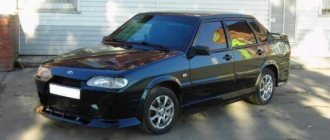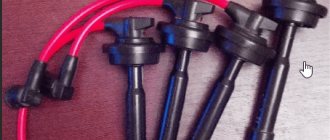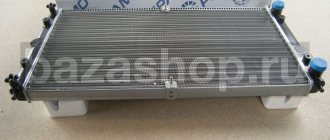Replacing rear shock absorbers on Niva
On a car like the VAZ 2121, you can often notice severe wear on the rear shock absorbers; the owners of the car simply do not have time to replace them - work, fishing, hunting and other entertainment. On the road you can hear terrible sounds as the car turns into a turn - this is generally fantastic, but when the shock absorbers also start leaking - it’s better to say nothing at all. In order not to listen to the variety of sounds of a car with a faulty suspension, today we will publish a detailed guide on the topic - how to replace the rear shock absorbers on a Niva with your own hands.
To replace the rear shock absorbers on a VAZ 2121, 21213 or 21214, we will need the following tools:
1. Convenient hammer. 2. Ratchet handle. 3. Collar. 4. Socket wrench 19. 5. Socket socket 19. 6. Lubricant.
Video. Demonstration of the rear shock absorber for VAZ 2121
It is worth recalling that in the previous article we looked at how to replace the pump on a Niva with your own hands. The procedure is quite simple, you can do it even on the road, the main thing is to have the necessary tools and a new part with you.
Do-it-yourself replacement of rear shock absorbers on a Niva
Before you begin removing faulty shock absorbers, you need to apply penetrating lubricant to all connections that you will need to unscrew. We wait 5-10 minutes and get to work.
To make it more convenient for you, I recommend lifting the rear part of the VAZ 2121 with a jack; now you will have more access to the lower shock absorber mount. It needs to be unscrewed, see the image for more details.
Now it's time for the hammer. We take a wooden block and gently hit it with a hammer to remove the bolt. In my case, even penetrating lubricant did not make the task easier for me; I used a hammer without a wooden block.
When the bottom bolt has already been removed, we proceed to the upper part. The steps are the same as the previous ones, see photo.
We knock the rear shock absorber off the top stud and everything is ready, now it’s time to install a new one.
To buy a new rear shock absorber for the Niva, I went to a car store, the cost last year was 400-700 rubles. The difference is which one you want to purchase - gas or oil, I purchased gas and installed it in the reverse order. It took me about two hours to remove and install.
Source
Niva rear skirt repair
Messages: 671 Registered: 06 Nov 2007, 00:00 Experience: 1997 :
Awards: 1
| Rating: 721 |
| Reputation: 0 |
Thanked: 1 time
Post by Ewgen » Jun 15, 2012 11:15 am
Don't be in too much of a hurry with circumcision, otherwise you'll have to weld it back on later. If you want to drive in RAF, read the TT, decide which category you want to ride in, and then start making modifications.
Messages: 325 Registered: Jan 05, 2012, 00:00 From: Tyumen Experience: 16 years Car: Niva 21213
| Rating: 1 175 |
| Reputation: +3 |
Thanked: 11 times
Post by yura78 » June 15, 2012, 12:13 pm
Messages: 671 Registered: 06 Nov 2007, 00:00 Experience: 1997 :
Awards: 1
| Rating: 721 |
| Reputation: 0 |
Thanked: 1 time
Post by Ewgen » Jun 15, 2012 1:05 pm
so many people redo it so that it’s in the “standard”, and then they fly straight away to TR2-3
Messages: 325 Registered: Jan 05, 2012, 00:00 From: Tyumen Experience: 16 years Car: Niva 21213
| Rating: 1 175 |
| Reputation: +3 |
Thanked: 11 times
Post by yura78 » Jun 15, 2012, 5:17 pm
Thanks for the link, I re-read everything. I'll probably have to install a new apron. Has anyone strengthened the rear bumper, if so how?
Added after 18 hours 32 minutes 57 seconds:
Source
Replacement of rear and front shock absorbers
The Niva 2121’s predominant habitat (off-road) and the inconsistent quality of components impose a number of concerns on the owner, for example, replacing shock absorbers. The average mileage of these components is 50 thousand km.
Signs of malfunctions: A serious signal for repairs will be: • prolonged rocking; • jamming in extreme positions; • knocking, crunching and other sounds; • appearance of “breakdowns”; • increase in braking distance. The above inevitably affects traffic safety and must be corrected in the near future.
How to check the status
To diagnose shock absorber struts, 3 methods are used: 1. Place the car on a level surface. Grasp the rear and front bumpers alternately and swing them forcefully. Serviceable shock absorbers will dampen vibrations in no more than the third time. 2. Using a vibration table, test and analyze the vibration graph according to the standard. Additionally, this method will allow you to identify problems with springs, silent blocks and other suspension elements. 3. Remove the lower mount of the rack, then manually bleed it. The compression of the rod should occur without jerking or excessive force.
Options
Characteristics based on the example of factory-installed products from SAAZ: 1) Front pillar size: • initial length (compressed) – 220 mm; • total length (when hanging) – 303.5 mm; • rod – 11 mm; • casing – 50 mm.
2) Rear shock absorber size: • initial length (compressed) – 310.5 mm; • total length (when hanging) – 429 mm; • the diameters of the rod and casing are similar to the front ones. You can clearly see the location of the racks in the drawings presented below.
Shock absorbers NIVA
The content of the article:
- Shock absorber sizes for Niva
- Suspension modernization: shock absorbers from Pajero-2 to NIVU
- Impressions after modernizing the suspension (shock absorbers from Pajero-2)
- Mounting rear shock absorbers from a Chevy Niva to NIVU
- Comparison of Monroe Adventure and SS20 comfort shock absorbers for Niva
Shock absorber sizes for Niva
VAZ 2121 Front
length in compressed position (length measured at the centers of the eyes and the middle of the pins) - 220 mm; stroke - 83.5 mm; rod diameter - 11 mm; tank diameter - 41.5 mm; casing diameter - 50 mm;
Nominal forces at a piston speed of 0.31 m/s, N (kgf) - during the rebound stroke - 120...154 kgf; — during the compression stroke — 17...31 kg.
length in compressed position (length measured at the centers of the lugs and the centers of the pins) - 310.5 mm; stroke - 181.5 mm; rod diameter - 11 mm; tank diameter - 41.5 mm; casing diameter - 50 mm;
Nominal forces at a piston speed of 0.31 m/s, N (kgf) - during the rebound stroke - 114...146 kgf; — during the compression stroke — 22…36 kg.
Shock absorbers VAZ 2123 Front
Connecting dimensions (mm) Maximum 351 Minimum 233
Piston stroke, mm 118
Nominal forces at piston speed 0.31 m/s, N (kgf) compression stroke 329 (33.57) rebound stroke 1740 (177.5)
Connecting dimensions (mm) Maximum 526 Minimum 326
Piston stroke, mm 200
Nominal forces at piston speed 0.31 m/s, N (kgf) compression stroke 329 (33.57) rebound stroke 1740 (177.5)
Suspension modernization: shock absorbers from Pajero-2 to NIVU
My new suspension kit
My last step, from what I planned after buying the car a little over a year ago, regarding modifications to the Nivas in the technical part, was the modernization of the standard suspension. Global elevator, using elevator kit, etc. It wasn’t originally planned, because: I don’t participate in competitions, the car drives on asphalt 70% of the time, the main purpose of my Nivas is everyday driving, fishing trips, mushroom picking and amateur off-road driving. To solve problems in cross-country ability, 28 mud wheels and 2 self-blocks are enough for me. In addition, I really like to drive quite dynamically and quickly both on asphalt and on dirt roads. And so the main goals of modernizing the suspension are: 1. Improving controllability and directional stability both on asphalt and on a grader; 2. Maximum reduction in “goatiness” - a disease characteristic of any short Niva (it’s practically impossible to completely get rid of it) 3. Maximum reduction in “throwing” of the rear axle at speed when passing bumps, I think everyone knows how often the rear axle of a short Niva lives on its own. 4. Increased suspension survivability off-road. 5. An easy lift that does not entail modifications to the rear suspension arms, increased wear on the front CV joints and, most importantly, deterioration in handling. Initially, an option was planned with installing springs from a Chevrolet Niva in a circle (or springs from a Niva 214-M on the front) and oil-oiled SAAZ shock absorbers, also from Shniva, but after talking with friends from our local off-road club, they suggested to me an option with gas-oil shock absorbers from Mitsubishi-Pajero -2. After this there was a week of daily studying in the evenings of various Nivo and Shnivo forums and sites, including here on Drive - I read a lot of information, in the Shnivo Club there is generally a separate very large topic on this matter. In general, I learned that many people are already practicing such shocks and everyone, without exception, is happy. I thoroughly studied the dimensions of the shock absorbers, the catalog numbers that I need, etc. When choosing a company, the preference of most Niv and Shniv owners is to pay attention to the subsidiary. Country of origin: Japan or Taiwan. Many on the forums installed both, for example, Japan in the back, Taiwan in the front, or vice versa, many drove first Japan, then Taiwan, and mostly the reviews are such that there is not much difference in either performance or durability, Taiwan produces under license from Japan, originally from a Japanese company. The applicability of such shock absorbers is Mitsubishi Pajero-2 1994 - 1998. And so we purchased: 1. Front gas-oil shock absorbers “Tokico”
What are the best shock absorbers to install?
Since native hydraulic (oil) ones are not comfortable - they are prone to swinging, breakdowns, rolls - Niva 21214 owners try to purchase products from foreign manufacturers: 1) Koni Special (gas) - unlike the original, they have a 10 mm longer maximum length in front and on the 70 mm - rear. They also have adjustable stiffness depending on the preferred driving style. They are characterized by increased rigidity and reduce the vehicle’s reaction time to steering movements. 2) Bilstein Sport (gas) - suitable for those who are not used to feeling sorry for their car. Extremely resistant to breakdown, forgives serious piloting errors. 3) Sachs Superturing (oil) – provide a balance between comfort and controllability, which allows you to feel the car well on the asphalt and not get tired when overcoming a grader. 4) KYB Excel-G (gas) – popular among lovers of comfortable driving on all types of surfaces. Resistant to frost and heat, reduces acoustic load. 5) BOGE Turbo24 (gas) - eliminate longitudinal rocking, allows you to receive 100% information about the road and just as accurately set the direction of movement. 6) Monroe Adventure (gas) – similar in characteristics to Sachs, but allow above average rolls, while willingly “swallowing” large potholes. It is worth considering that opinions about which rear and front shock absorbers are better are in most cases subjective. You can make an approximate conclusion by driving a car with the corresponding model of struts.
Which hard and soft shock absorbers are better to install on a Chevy Niva
02.03.2020
Chevrolet Niva shock absorbers play an important role. They dampen shocks and vibrations of moving elements (wheels, suspensions) that occur during movement. As a result, wheel traction improves and the ride becomes comfortable for all passengers.
Over time, the device may fail, so it is important for the owner to know all the suitable shock absorbers for the Chevrolet Niva, which ones are better and how to replace them yourself, so as not to spend a lot of money on visiting a car service center.
Types and sizes of shock absorbers installed on Chevrolet Niva by the manufacturer
Shock absorbers for the factory equipment of the car are manufactured at the Skopinsky Automotive Assembly Plant (SAAZ for short), located in the village of Chulkovo. SAAZ oil devices are reliable during operation at a calm driving pace. Their main advantage is their relatively low cost.
This plant also produces gas-oil models, in which, in addition to oil, inert gas is pumped. Gas-oil SAAZ models are distinguished by increased combat forces. They better press the wheels to the road surface. This makes the entire suspension stiffer, so the car is more stable when driving fast and when cornering.
Car shock absorbers do not have divisions depending on the side of installation. Their dimensions are the same for all models:
| Installation location | Product code | Rod diameter, mm | Case diameter, mm | Case height, mm | Rod stroke, mm |
| Front | 21236290500400X | 12,5 | 45 | 231 | 118 |
| Rear | 212302915004000 | 12,5 | 45 | 326 | 200 |
Many owners of cars with factory-installed shock absorbers claim that they make unpleasant sounds when driving on uneven surfaces.
Popular analogues of standard shock absorbers and their cost
Shock absorbers for the Chevrolet Niva are produced by dozens of companies from China, Russia, Japan and Europe. Let's consider the most popular analogues available on the domestic market in the public domain:
- KAYABA (Kayaba) is a manufacturing company that is considered to be one of the best in the production of shock absorbers. Models are specially designed for use in bad weather conditions. They help keep the car under control on rough roads and sharp turns.
- SS20 (Technology System) is a company that has been producing high-quality suspensions and their components in Russia since 1993. Their auto parts are reliable and durable.
- Boge (God) is a company located in Germany, and specializes in the production of car suspension elements. During production, parts are specially hardened, chrome-plated and micropolished, which ensures their unique characteristics during driver use.
- SAAZ (Skopinsky Automotive Aggregate Plant) is an engineering company that has been supplying auto parts for domestic manufacturers since the 50s of the 20th century. SAAZ is constantly expanding its range of rack auto components with improved consumer qualities. Many car owners try to purchase high-quality, reliable auto parts at low prices, so the company’s products are in high demand.
The cost of front and rear shock absorbers for Chevrolet Niva from the above manufacturers is indicated in the table:
| Manufacturer | Installation location | Type | Price, rub |
| KAYABA | Front | Oil | 1560 |
| KAYABA | Rear | Oil | 1830 |
| KAYABA | Front | Gas-oil | 2700 |
| KAYABA | Rear | Gas-oil | 2500 |
| SS20 | Front | Oil | 3500 |
| SS20 | Rear | Oil | 3790 |
| SS20 | Front | Gas-oil | 4800 |
| SS20 | Rear | Gas-oil | 4500 |
| SAAZ | Front | Oil | 1070 |
| SAAZ | Rear | Oil | 1130 |
| SAAZ | Front | Gas-oil | 1090 |
| SAAZ | Rear | Gas-oil | 1050 |
| Boge | Oil | 1320 | |
| Boge | Rear | Oil | 1070 |
| Boge | Front | Gas-oil | 1560 |
| Boge | Rear | Gas-oil | 1280 |
According to user reviews, Japanese KAYABA models have proven themselves best in fast driving conditions. They provide comfortable driving on any road surface. However, after the factory shock absorber, the car seems too heavy to drive.
SS20 models are comparable in performance to Japanese auto parts. They are just as reliable and easy to use, but at the same time they cost almost 2 times less.
SAAZ and Boge produces soft, comfortable and inexpensive models. They are quite reliable unless you drive off-road.
Which shock absorbers are better to install on a Chevrolet Niva
Chevrolet Niva owners have a question about which of the options offered on the Russian market are the best. There is no clear answer here. It all depends on the conditions in which the car is operated. Based on the requirements, they already choose a specific brand.
Soft
If the car owner plans to move quietly around the city, where there are relatively smooth roads and moderate traffic, then he needs to purchase soft shock absorbers. Their best options are shown in the table:
Replacing front shock absorbers
To perform repair operations you will need: • A jack (preferably hydraulic); • WD-40; • Hammer or sledgehammer; • Spanner 17 mm; • Socket head 19 mm; • Open-end wrench 6 mm; • Collar. Before removing the front shock absorber, it is advisable to treat the connections with a penetrating lubricant. Moreover, it is recommended to do this 15-20 minutes before the start of the main work. Lift the car in a convenient way until the wheel is completely free.
Unscrew the fastening from the top, holding the rod firmly with a 6 mm wrench.
Remove the washer by hand.
Remove the rubber damper.
By moving the rack downward, release the rod from the body bracket.
Move to the spring cup and use two 17mm socket wrenches to unscrew the lower mount.
Remove the shock absorber from its seat, first removing the bolt.
You can replace the front shock absorber with a new one in the reverse order. In this case, the final broaching is carried out with a naturally loaded axis.
Replacement of Niva 4x4 shock absorbers and their mounting brackets
It is recommended to carry out work on replacing Niva 4x4 Urban shock absorbers strictly in a certain sequence.
Front suspension instructions
The work of replacing the front shock absorber is performed in the following sequence:
- Loosen the wheel nuts.
- Raise the car on a jack.
- Remove the wheel.
- Unscrew the strut nut from the engine compartment side, while holding the rod from turning with a 6 mm wrench.
- Remove the washer and damper.
- Unscrew the lower rack mounting.
- Remove the shock absorber from its seat.
Install the new strut assembly in the reverse order of removal.
Attention! Even if only one shock absorber fails, both front shock absorbers should be replaced.
Replacing rear shock absorbers
Provide unobstructed access to the rear axle using a jack, pit or lift.
Loosen the lower shock absorber mounting bolt from the 17 mm nuts using two spanners.
A hammer or sledge hammer may be needed to remove the bolt. To avoid damaging it, use a wooden block as a spacer. To make the process easier, pre-press the spring in a suitable manner.
As a result, you will have in your hands: a spacer sleeve, a bolt and a spacer washer.
Unscrew the upper fastening pin. Remove the washer and then the strut eye.
Please note that rubber bushings are installed at the top and bottom, which may not be available on the shock absorbers you purchase.
How to remove the rear shock absorbers of a VAZ 2121 Niva 2131
Removal of rear shock absorbers on a VAZ 2121 and Niva 2131 is carried out in case of their failure for subsequent replacement or repair. Replacement is carried out when the shock absorbers are not dismountable; in other cases, it can be repaired, unless the body is damaged or the rod is deformed. As a rule, repairs consist of replacing rubber elements to restore tightness.
Before proceeding with removal, the racks must be checked. To do this, we rock the body on the shock absorbers, as a rule, when they are faulty, it swings softly and smoothly from side to side on the springs alone; if the shock absorbers are working properly, then the body will swing more rigidly, without making oscillatory movements on the springs.
To carry out repair work, prepare a standard set of tools, and then perform the following sequence of actions:
We hang the side to be repaired on jacks, and then remove the wheel. Next, install a support under the rear beam on the side of the shock absorber mounting bracket and lower the body a little, thereby compressing the spring.
Next, using two nineteen keys, unscrew the nut of the lower bolt securing the shock absorber to the bracket on the rear axle. Use one of the keys to hold the bolt from turning. Using a bead of suitable diameter, we knock the bolt out of its seat and remove the spacer sleeve.
Then completely remove the bolt and its spacers.
Next, use the same wrench to unscrew the top nut securing it to the pin on the body. Remove the nut.
Mounting rear shock absorbers on Niva 21214
1200 rub. for the photo report
We pay for photo reports on car repairs. Earnings from 10,000 rubles/month.
Write:
Changing the rear shock absorber on a Niva VAZ-21214 with your own hands will not be difficult, but to be more confident, it is better to watch a video or photo on replacing the shock absorber. The rear shock absorber is secured with just two 19mm wrench bolts, and you can’t do without a hammer and a wedge, since I attach the bolts tightly. We begin installing the new shock absorber from the top, having first installed the rubber bands. It is better to carry out work on replacing the rear shock absorber in the inspection pit.
Before installing a new shock absorber, be sure to bleed it first.
The time has come to change the amas, and I thought about what to install. Many thanks to Cockchafer for the excellent FAQ article. After reading the article, I wrote out the ones I liked and went to the store. In the store, the only ones I liked were kayabas, but I didn’t want to turn on the gas. There was also hydraulics for the ShNiva. A survey of sellers showed their complete ignorance in this matter, so they had to return home and go online again. Having looked through the forum with a search, I was able to find information that someone had installed Ams from ShNiva, but it was not written how. I'm filling this gap.
Shock absorbers Kayaba Premium, black:
Front GM NIVA-F 444266, rear GM NIVA-R 444267.
The amas from Shniva are a little longer, so a slight lift is possible:
The front ones fit without any problems. You'll have to tinker with the rear ones.
Firstly, before purchasing, please note that they will not fit without modifications. This means either goodbye to the store’s warranty, or you’ll have to redo the upper mount on the body. I didn’t touch the body and forgot about the warranty, relying on the quality of the Japanese.
So, if you still decide, let’s get started.
The difference between these amos and the standard ones is that they initially have a silent block pressed into them (which is very good) along with a bushing, which actually does not fit onto the upper mount (which is bad). Practice has shown that it is impossible to press out this very bushing, it sits dead (later it turned out that they are glued together), I had to scrape it off with a knife (photo on the left). This means that the silent block itself needs to be changed. To do this, you need to sharpen the flaring (with a grinder, a file) and press out the silent block.
How to check the status
To diagnose shock absorber struts, 3 methods are used: 1. Place the car on a level surface. Grasp the rear and front bumpers alternately and swing them forcefully. Serviceable shock absorbers will dampen vibrations in no more than the third time. 2. Using a vibration table, test and analyze the vibration graph according to the standard. Additionally, this method will allow you to identify problems with springs, silent blocks and other suspension elements. 3. Remove the lower mount of the rack, then manually bleed it. The compression of the rod should occur without jerking or excessive force.
Options
Characteristics based on the example of factory-installed products from SAAZ: 1) Front pillar size: • initial length (compressed) – 220 mm; • total length (when hanging) – 303.5 mm; • rod – 11 mm; • casing – 50 mm.
2) Rear shock absorber size: • initial length (compressed) – 310.5 mm; • total length (when hanging) – 429 mm; • the diameters of the rod and casing are similar to the front ones. You can clearly see the location of the racks in the drawings presented below.
What are the best shock absorbers to install?
Since native hydraulic (oil) ones are not comfortable - they are prone to swinging, breakdowns, rolls - Niva 21214 owners try to purchase products from foreign manufacturers: 1) Koni Special (gas) - unlike the original, they have a 10 mm longer maximum length in front and on the 70 mm - rear. They also have adjustable stiffness depending on the preferred driving style. They are characterized by increased rigidity and reduce the vehicle’s reaction time to steering movements. 2) Bilstein Sport (gas) - suitable for those who are not used to feeling sorry for their car. Extremely resistant to breakdown, forgives serious piloting errors. 3) Sachs Superturing (oil) – provide a balance between comfort and controllability, which allows you to feel the car well on the asphalt and not get tired when overcoming a grader. 4) KYB Excel-G (gas) – popular among lovers of comfortable driving on all types of surfaces. Resistant to frost and heat, reduces acoustic load. 5) BOGE Turbo24 (gas) - eliminate longitudinal rocking, allows you to receive 100% information about the road and just as accurately set the direction of movement. 6) Monroe Adventure (gas) – similar in characteristics to Sachs, but allow above average rolls, while willingly “swallowing” large potholes. It is worth considering that opinions about which rear and front shock absorbers are better are in most cases subjective. You can make an approximate conclusion by driving a car with the corresponding model of struts.
How to replace rubber bands on Chevrolet Niva shock absorbers
› AvtoVAZ
20.08.2019
The dull loud sound of hitting metal, coming from the front left wheel, began to hurt my ear. This sound was so loud in the cabin, coming from every small bump in the road, that I thought I was going to tear something off. Having driven into the pit, I didn’t find anything suspicious or criminal in the suspension, but it was still scary to drive. Having reached the lift at the car service center, the verdict was not reassuring; the silent blocks on the front shock absorbers were completely broken.
In the field, I used KYB shock absorbers (gas-oil) faithfully, both in the front and in the rear. After visiting several stores, I was informed that the shock absorbers of this company are not serviced but replaced as a whole. The price tag started from 2400 per piece
, at the same time, I understood that my shock absorbers were fully functional and it was only a matter of silent blocks. Returning to the garage, I began to remove the shock absorber and look at what could be done.
Replacing front shock absorbers
To perform repair operations you will need: • A jack (preferably hydraulic); • WD-40; • Hammer or sledgehammer; • Spanner 17 mm; • Socket head 19 mm; • Open-end wrench 6 mm; • Collar. Before removing the front shock absorber, it is advisable to treat the connections with a penetrating lubricant. Moreover, it is recommended to do this 15-20 minutes before the start of the main work. Lift the car in a convenient way until the wheel is completely free.
Unscrew the fastening from the top, holding the rod firmly with a 6 mm wrench.
Remove the washer by hand.
Remove the rubber damper.
By moving the rack downward, release the rod from the body bracket.
Move to the spring cup and use two 17mm socket wrenches to unscrew the lower mount.
Remove the shock absorber from its seat, first removing the bolt.
You can replace the front shock absorber with a new one in the reverse order. In this case, the final broaching is carried out with a naturally loaded axis.
Replacing rear shock absorbers
Provide unobstructed access to the rear axle using a jack, pit or lift.
Loosen the lower shock absorber mounting bolt from the 17 mm nuts using two spanners.
A hammer or sledge hammer may be needed to remove the bolt. To avoid damaging it, use a wooden block as a spacer. To make the process easier, pre-press the spring in a suitable manner.
As a result, you will have in your hands: a spacer sleeve, a bolt and a spacer washer.
Unscrew the upper fastening pin. Remove the washer and then the strut eye.
Please note that rubber bushings are installed at the top and bottom, which may not be available on the shock absorbers you purchase.
How to replace the rear suspension shock absorber of a VAZ-21213
You can verify the performance of the shock absorber without special equipment by vigorously shaking the car body down.
The body should return to its original position without oscillating
The fastening of shock absorbers should not have any play, and no leaks of working fluid are allowed on their bodies.
Rubber bushings for mounting shock absorbers must be free of damage and local bulging.
A more accurate characteristic of the performance of shock absorbers can be viewed on a dynamometer.
Removing the shock absorber
We carry out the work on an inspection ditch or a lift.
Using a 19mm spanner, unscrew the nut of the shock absorber lower mounting bolt, holding the bolt from turning with a wrench of the same size.
Before removing the bolt with the rear axle beam suspended (when working on a lift), it is necessary to place a support under the part of the beam where we remove the shock absorber so that the suspension spring is compressed.
Remove the spacer sleeve.
Remove the bolt and spacer washer.
Using a 19mm spanner, unscrew the pin nut of the upper shock absorber mounting
After removing the upper eye from the pin, remove the shock absorber.
The lower eye of the shock absorber has two rubber bushings and a metal spacer bushing.
There are two rubber bushings in the upper eyelet
Install the shock absorber in reverse order.
We finally tighten the shock absorber mounting nuts in the “car on wheels” position.
The tightening torque of the shock absorber mounting bolt nut is 38.2 – 61.7 Nm (3.9 – 6.3 kgf m).
